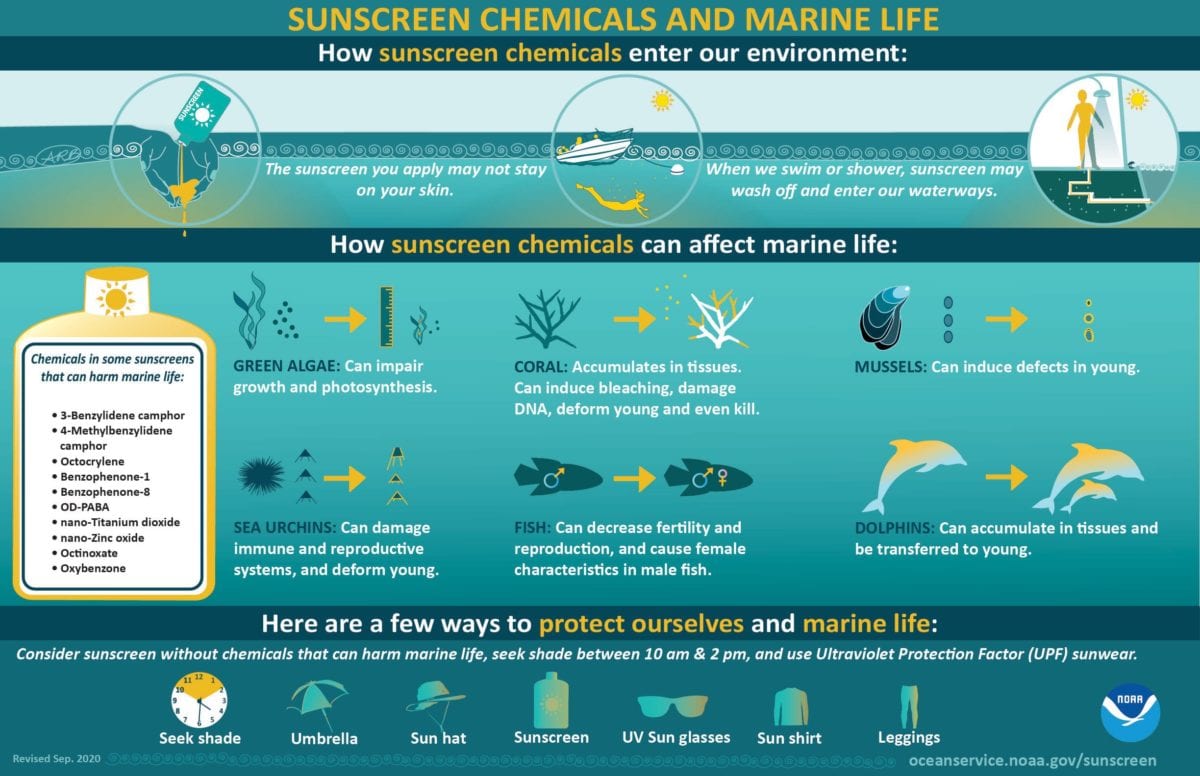Credit Tourism & Events Queensland
Conscious Travel / Why and how to choose a reef safe sunscreen
Did you know that it only takes less than 20 minutes in water for more than 1/4 of the cream spread on your body to end up in the sea? This is how, each year, around 14,000 tons of sunscreen are released into our oceans and ultimately harm corals and marine life.
Let’s understand what are the causes of these terrible impacts and how to choose a reef safe sunscreen to limit them.
What are the most common harmful ingredients?
Unfortunately, scientific studies showed that some sunscreens chemical compounds are an even greater threat to corals than global warming and pollution. And with coastal tourism constantly increasing, coral reefs are fastly deteriorating. For example in recent years these coral reefs have been destroyed to the tune of:
- 40% in Hawaii
- 40% in the Great Barrier Reef
- 85% in the Caribbean
- 99% in the Florida Keys
The 2 main sunscreen ingredients responsible for harming corals are oxybenzone and octinoxate, the most common UV-blocking chemicals.
And since they are usually present in sunscreen in the form of nanoparticles, they are even more easily ingested by corals.
The state of Hawaii (USA) was the first to ban the sale of sunscreens containing these two chemical ingredients in 2018 (effective since January 2021) in order to protect its coral reefs.
See in this infographic from NOAA how sunscreen chemicals affect marine life:
How to choose a reefsafe sunscreen?
Look for harmful chemical ingredients in the formula
“Reef Safe” claims not being yet regulated, the best way to choose a reef safe sunscreen is to check the list of ingredients to ensure that reef harming chemicals are not included in the formula.
The ones present in this non exhaustive list are to avoid:
- Benzophenone (BP-2, BP-1, BP-3) or Oxybenzone
- 4-methylbenzylidene camphor (4-MBC) (and other camphor derivatives)
- 3-benzylidene camphor (3-BC)
- Ethylhexyl methoxycinnamate
- Octyl-methoxycinnamate (OMC) or Octinoxate
- Octocrylene (OC)
- Para-aminobenzoic acid (PABA)
- Padimate O, Octyl salicylate, Trolamine Salicylate
- Cinnamate / Cinoxate
- Titanium (in Aluminum or Dimethicone)
Choose a sunscreen with mineral ingredients
Zinc oxide and titanium dioxide are the 2 active ingredients to prefer because they are not harmful to corals. But this is only if they are NOT present in the form of nanoparticles. If they are too small, they will be ingested by corals (see the next point).
Choose a sunscreen without any NANO ingredients
Any ingredient in the form of a nanoparticle will be harmful to marine life as it will be easily ingested by corals. Whether it is a mineral ingredient or a plastic microbead, they should be avoided. You can easily identify them in the formula looking for the word “nano”.
Avoid Parabens
These are groups of synthetic components widely used as a preservative but harmful for the hormonal function of underwater life and humans (Ex: Methylparaben, Butylparaben, Propylparaben).
Use rub-on lotions rather than sprays
With sprays, half of the product often flies away during the application to land on the sand or around you, ultimately harming the environment.
Choose a water resistant sunscreen and wait before going in the water
Water-resistant sunscreen will stay longer on the skin and is therefore less likely to be washed into the ocean, thus providing a longer protection for you.
Wait at least 10 minutes for the sunscreen to be absorbed by your skin before going in the water.
Favour eco-responsible packagings
A packaging that is recyclable or reusable, ideally without any plastic or additional cardboard wrapping that will be thrown away just after purchase.
Be aware of greenwashing
Don’t be fooled by the “Reef Safe”, “Ocean Friendly”, “Eco-responsible”, etc. claims on packaging because there is no official regulation yet. The best way is still for you to check the ingredients in the formula.
Wear protective clothing
A good alternative to applying too much sunscreen is to wear protective clothing such as a rash vest. The less skin you have to apply sunscreen on, the less product is going to be washed off in the ocean!
Author
Lorène
Travel Consultant
My family and friends have always called me Lolo the adventurer: impossible for me to stay put for too long. I need to move, to explore and to travel constantly to be happy, and never without my camera!
More articles from this author
Categories
Newsletter
Get our latest posts and info in your inbox.



